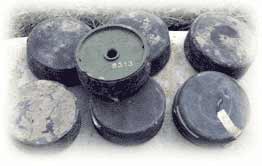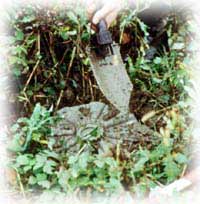The World of Technology
Researchers ABUZZ About Bees as Land Mines Detectors
By Paul Stone
American Forces Press Service

WASHINGTON — The latest buzz from the Pentagon is a honey of a story: The military’s trying to train bees to locate land mines.
And if a swarm of honeybees doesn’t sound like your typical military unit, how about a battalion of beetles, a legion of lobsters and a gaggle of geckos? They’ve all been drafted into a DoD effort to explore, and possibly harness, the natural capabilities of the zoological kingdom.
The larger research project is known as the “Controlled Biological and Biomimetic Systems” program, said Rudolph, program manager in DARPA’s Defense Sciences Office. For more information on it, see the accompanying story
“Creatures Feature Possible Defense Applications.”
First, the honeybees.

Under a $3 million program funded by DARPA, scientists and engineers at various research and development centers across the United States have been working with honeybees and developing technologies to turn the insects into information collectors wearing tracking devices that may help pinpoint mines within a designated area.
Later this year, engineers from the Pacific Northwest National Laboratory and the University of Montana will fit 50 bees with the radio tags and release them into a minefield to see if the combination of insect and technology works. The tags, no larger than half a grain of rice, will be attached to the backs of the bees.
Scientists will track the bees using complex electronics, software and computers, some located in an engineered bee hive. Each time a bee leaves the hive, scientists will know its direction of flight, points where the bees landed and flight time. Inside the hive, special sensors will scan for chemicals brought back on the bees’ bodies. Scientists believe the tracking information, combined with the chemical analysis, will help pinpoint the locations of mines.
Why honeybees?
Rudolph said the insects have been used for many years to collect environmental information, such as the presence of pollutants or trace materials on plants. He said the Environmental Protection Agency registered honeybees as valid data collectors — their mop-like bodies soak up any contaminants they contact. Additionally, Rudolph said social animals such as bees and dogs are highly trainable and respond well to positive reinforcement and rewards.

Sandia National Laboratory, near Albuquerque, N.M., is conducting a sort of basic training for the bees this summer. The goal is for the bees to recognize the smell of TNT and associate it with food. The explosive routinely seeps from land mines and can be found on surrounding plant life.
The training focuses on “associative learning.” Rudolph said scientists took sugar-soaked sponges mixed with traces of TNT to see if the bees would swarm to them. They gradually reduced the sugar and increased the TNT so the bees would begin to associate the smell of TNT as a possible food source.
Part of the experiment also includes testing to see how far the bees can be trained to locate the sugar-TNT mixture. Although emphasizing the testing is still in the early stages, Rudolph said results thus far indicate the bees may well prove useful for mine detection. After just a few hours of training, the bees were traveling up to 100 yards to reach the sponges.
Testing on the honeybees’ “mine sniffing” abilities and the radio frequency tags are proceeding smoothly, Rudolph said, but practical applications are likely years away.
“The project now has a trailer that can deploy a dozen bee hives,” he said. “Presumably, it would be brought to a location, the hives would be set up and within hours the bees would start to collect information.” Bees trained to associate TNT with food and equipped with radio tags would swarm to mines, and the tags would help pinpoint them, he said.
In addition to testing the bees’ effectiveness in a controlled minefield later this year and testing the technologies for receiving and processing data from the RF tags, Rudolph said, researchers will also be looking closely at bee behavior. For example, how far will they travel to look for the food source? How efficiently do they locate the mines? And how long do they retain the information learned during training?
Tests will then shift from controlled to real-world situations. And showing effectiveness under lab conditions and actual field deployments are two different things, Rudolph said.
“We don’t have visions of soldiers carrying bees into a fray,” he said. “We’ll be seeking out defense customers interested in helping us test some of these systems in real-world situations.”

While the honeybees’ mine detection training has received most of the news media’s attention recently, Rudolph pointed out that’s but one application being studied. Similar research is under way to determine if bees might be useful in detecting chemical and biological agents.
Nor are bees the only insects being studied for such applications. Testing is also ongoing to determine whether parasitic wasps can be trained to associate food with byproducts released by chemical or biological agents and to swarm where they might be stored. Similarly, giant sphinx moths are being studied to see if they, like wasps, can be trained to detect low levels of chemical compounds.
Man’s best friend may indeed be a dog, but if DARPA’s research projects prove successful, a soldier’s best friend may be the creatures they now swat, stomp or shoo.
Robotics




